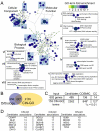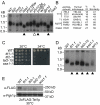The complete spectrum of yeast chromosome instability genes identifies candidate CIN cancer genes and functional roles for ASTRA complex components
- PMID: 21552543
- PMCID: PMC3084213
- DOI: 10.1371/journal.pgen.1002057
The complete spectrum of yeast chromosome instability genes identifies candidate CIN cancer genes and functional roles for ASTRA complex components
Abstract
Chromosome instability (CIN) is observed in most solid tumors and is linked to somatic mutations in genome integrity maintenance genes. The spectrum of mutations that cause CIN is only partly known and it is not possible to predict a priori all pathways whose disruption might lead to CIN. To address this issue, we generated a catalogue of CIN genes and pathways by screening ∼ 2,000 reduction-of-function alleles for 90% of essential genes in Saccharomyces cerevisiae. Integrating this with published CIN phenotypes for other yeast genes generated a systematic CIN gene dataset comprised of 692 genes. Enriched gene ontology terms defined cellular CIN pathways that, together with sequence orthologs, created a list of human CIN candidate genes, which we cross-referenced to published somatic mutation databases revealing hundreds of mutated CIN candidate genes. Characterization of some poorly characterized CIN genes revealed short telomeres in mutants of the ASTRA/TTT components TTI1 and ASA1. High-throughput phenotypic profiling links ASA1 to TTT (Tel2-Tti1-Tti2) complex function and to TORC1 signaling via Tor1p stability, consistent with the role of TTT in PI3-kinase related kinase biogenesis. The comprehensive CIN gene list presented here in principle comprises all conserved eukaryotic genome integrity pathways. Deriving human CIN candidate genes from the list allows direct cross-referencing with tumor mutational data and thus candidate mutations potentially driving CIN in tumors. Overall, the CIN gene spectrum reveals new chromosome biology and will help us to understand CIN phenotypes in human disease.
Conflict of interest statement
The authors have declared that no competing interests exist.
Figures




Similar articles
-
Mutability and mutational spectrum of chromosome transmission fidelity genes.Chromosoma. 2012 Jun;121(3):263-75. doi: 10.1007/s00412-011-0356-3. Epub 2011 Dec 24. Chromosoma. 2012. PMID: 22198145 Free PMC article.
-
Saccharomyces cerevisiae genetics predicts candidate therapeutic genetic interactions at the mammalian replication fork.G3 (Bethesda). 2013 Feb;3(2):273-82. doi: 10.1534/g3.112.004754. Epub 2013 Feb 1. G3 (Bethesda). 2013. PMID: 23390603 Free PMC article.
-
Overexpression screens identify conserved dosage chromosome instability genes in yeast and human cancer.Proc Natl Acad Sci U S A. 2016 Sep 6;113(36):9967-76. doi: 10.1073/pnas.1611839113. Epub 2016 Aug 22. Proc Natl Acad Sci U S A. 2016. PMID: 27551064 Free PMC article.
-
Maintenance of genome stability in Saccharomyces cerevisiae.Science. 2002 Jul 26;297(5581):552-7. doi: 10.1126/science.1075277. Science. 2002. PMID: 12142524 Review.
-
TTT (Tel2-Tti1-Tti2) Complex, the Co-Chaperone of PIKKs and a Potential Target for Cancer Chemotherapy.Int J Mol Sci. 2023 May 5;24(9):8268. doi: 10.3390/ijms24098268. Int J Mol Sci. 2023. PMID: 37175973 Free PMC article. Review.
Cited by
-
Histone Chaperone Paralogs Have Redundant, Cooperative, and Divergent Functions in Yeast.Genetics. 2019 Dec;213(4):1301-1316. doi: 10.1534/genetics.119.302235. Epub 2019 Oct 11. Genetics. 2019. PMID: 31604797 Free PMC article.
-
Systems genetics in the rat HXB/BXH family identifies Tti2 as a pleiotropic quantitative trait gene for adult hippocampal neurogenesis and serum glucose.PLoS Genet. 2022 Apr 4;18(4):e1009638. doi: 10.1371/journal.pgen.1009638. eCollection 2022 Apr. PLoS Genet. 2022. PMID: 35377872 Free PMC article.
-
FACS-based genome-wide CRISPR screens define key regulators of DNA damage signaling pathways.Mol Cell. 2023 Aug 3;83(15):2810-2828.e6. doi: 10.1016/j.molcel.2023.07.004. Mol Cell. 2023. PMID: 37541219 Free PMC article.
-
Dynamics of DNA damage-induced nuclear inclusions are regulated by SUMOylation of Btn2.Nat Commun. 2024 Apr 13;15(1):3215. doi: 10.1038/s41467-024-47615-8. Nat Commun. 2024. PMID: 38615096 Free PMC article.
-
The Saccharomyces cerevisiae cell lysis mutant cly8 is a temperature-sensitive allele of ESP1.bioRxiv [Preprint]. 2024 Oct 25:2024.10.23.619872. doi: 10.1101/2024.10.23.619872. bioRxiv. 2024. PMID: 39484378 Free PMC article. Preprint.
References
-
- Cahill DP, Kinzler KW, Vogelstein B, Lengauer C. Genetic instability and darwinian selection in tumors. Trends Cell Biol. 1999;9:M57–60. - PubMed
Publication types
MeSH terms
Grants and funding
LinkOut - more resources
Full Text Sources
Other Literature Sources
Molecular Biology Databases

